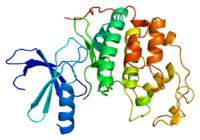
Photo from wikipedia
P21-activated kinases (PAKs) are serine/threonine protein kinases that are subdivided into two groups on the basis of their domain architecture: group-I (PAK1–3) and group-II (PAK4–6). PAKs are considered as attractive… Click to show full abstract
P21-activated kinases (PAKs) are serine/threonine protein kinases that are subdivided into two groups on the basis of their domain architecture: group-I (PAK1–3) and group-II (PAK4–6). PAKs are considered as attractive drug targets that play vital role in cell proliferation, survival, motility, angiogenesis and cytoskeletal dynamics. In current study, molecular dynamics simulation-based comparative residual contributions and differential transitions were monitored in both active and inactive states of human PAK homologs for therapeutic intervention. Due to their involvement in cancer, infectious diseases, and neurological disorders, it is inevitable to develop novel therapeutic strategies that specifically target PAKs on the basis of their activity pattern. In order to isolate novel inhibitors that are able to bind at the active sites of PAK1 and PAK4, high throughput structure-based virtual screening was performed. Multiple lead compounds were proposed on the basis of their binding potential and targeting region either phosphorylated (active) or unphosphorylated PAK isoform (inactive). Thus, ATP-competitive inhibitors may prove ideal therapeutic choice against PAK family members. The detailed conformational readjustements occurring in the PAKs upon phosphorylation-dephosphorylation events may serve as starting point for devising novel drug molecules that are able to target on activity basis. Overall, the observations of current study may add valuable contribution in the inventory of novel inhibitors that may serve as attractive lead compounds for targeting PAK family members on the basis of activity-based conformational changes.
Journal Title: PLoS ONE
Year Published: 2019
Link to full text (if available)
Share on Social Media: Sign Up to like & get
recommendations!